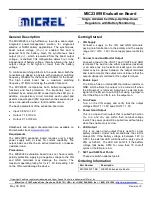
MIC23099 Evaluation Board
Single AA/AAA Cell Step-Up/Step-Down
Regulators with Battery Monitoring
General Description
The MIC23099 is a high-efficiency, low-noise, dual-output,
integrated power-management solution for single-cell
alkaline or NiMH battery applications. The synchronous
boost output voltage (V
OUT1
) is enabled first and is
powered from the battery. Next, the synchronous buck
output (V
OUT2
)
−
which is powered from the boost output
voltage
−
is enabled. This configuration allows V
OUT2
to be
independent of battery voltage, thereby allowing the buck
output voltage to be higher or lower than the battery
voltage.
To minimize switching artifacts in the audio band, both the
converters are design to operate with a minimum switching
frequency of 80kHz for the buck and 100kHz for the boost.
The high current boost has a maximum switching
frequency of 1MHz, minimizing the solution foot-print.
The MIC23099 incorporates both battery-management
functions and fault protection. The low-battery level is
indicated by an external LED connected to the LED pin. In
addition, a supervisory circuit monitors each output and
asserts a power-good (PG) signal when the sequencing is
done or de-asserted when a fault condition occurs.
The basic parameters of the evaluation board are:
•
Input: 0.85V to 1.6V
•
Output 1: 1.8V/0.2A
•
Output 2: 1.0V/30mA
Datasheets and support documentation are available on
Micrel’s web site at:
www.micrel.com
.
Requirements
The MIC23099 evaluation board requires only a single
power supply with at least 1A current capability. The
output load can either be an active (electronic) or passive
(resistive) load.
Precautions
The MIC23099 evaluation board does not have reverse
polarity protection. Applying a negative voltage to the VIN
and GND terminals may damage the device. The
maximum operating rating for V
IN
is 1.6V. Exceeding 1.6V
on the VIN could damage the device.
Getting Started
1. VIN Supply
Connect a supply to the VIN and GND terminals,
paying careful attention to the polarity and the supply
range (0V < VIN < 1.6V). Do not apply power until step
4.
2. Connect Load and Monitor Output
Connect a load to the VOUT1 and VOUT2 and GND
terminals. The load can be either a passive (resistive)
or an active (as in an electronic load) type. A current
meter may be placed between the output terminals
and load to monitor the output current. Ensure that the
output voltage is monitored at the output terminals.
3. Enable Input
The EN pin has an internal 4M
Ω pull-down resistor to
GND, which allows the output to be turned off when
the EN jumper is removed. Applying an external logic
signal on the EN pin to pull it high or using a jumper to
short the EN pin to VIN to turn the outputs on.
4. Turn Power
Turn on the VIN supply and verify that the output
voltages VOUT1 = 1.8V and VOUT2 = 1.0V.
5. Power Good Output
This is on open drain output that is pulled high when
V
IN
, V
FB1
and V
FB2
are within their nominal voltage
levels. The power good will be pulled low without delay
when the enable pin is set low.
6. LED Output
This is an open drain output that is used for a low
battery indicator. Under normal conditions, the LED is
always ON. If the battery voltage is between 1.2V to
0.85V, the external LED will blink with a duty cycle of
25% at 0.25Hz. The LED will be OFF if the battery
voltage falls below 0.85V for more than 15 cool-off
cycles or the EN pin is low.
7. SW1 and SW2 Test Points
These are switch node test points.
Ordering Information
Part Number
Description
MIC23099YFT EB
MIC23099 Evaluation Board
HyperLight Load is a registered trademark and Hyper Speed Control is a trademark of Micrel, Inc.
Micrel Inc. • 2180 Fortune Drive • San Jose, CA 95131 • USA • tel +1 (408) 944-0800 • fax + 1 (408) 474-1000 •
http://www.micrel.com
May 30, 2014
Revision 1.0











